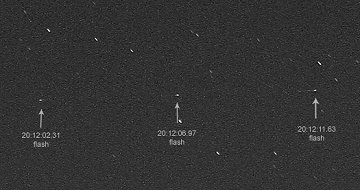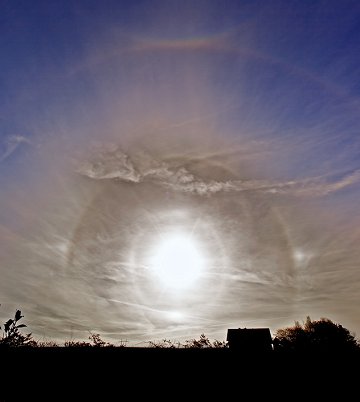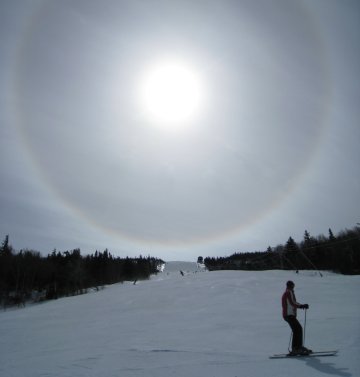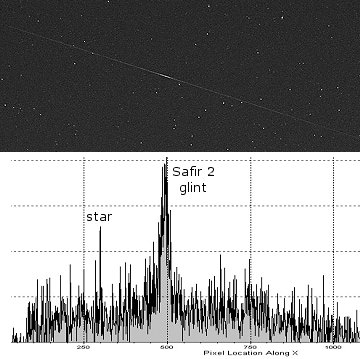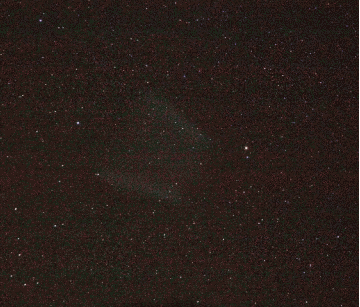|
On March 6, 2009 there were
1035
potentially hazardous asteroids.
March 2009 Earth-asteroid
encounters:
Notes: LD means "Lunar Distance." 1 LD = 384,401 km, the distance between Earth and the Moon. 1 LD also equals 0.00256 AU. MAG is the visual magnitude of the asteroid on the date of closest approach.
| |||||||||||||||||||||||||||||||||||||||||||||||||||||||||||||||||||||||||||||||||||||||
| 3-31-09 - No sunspots today
Current conditions
Solar wind speed: 369.4 km/sec density: 1.4 protons/cm3 explanation | more data Updated: Today at 2345 UT X-ray Solar Flares 6-hr max: A0 2340 UT Mar31 24-hr: A0 2340 UT Mar31 explanation | more data Updated: Today at: 2340 NOT A
ROCKET:
News
reports that a Russian rocket fell over the US
mid-Atlantic coast on Sunday evening, March 29th, are
probably incorrect. A spent Russian rocket booster did
reenter Earth's atmosphere on March 29th, but apparently
not over the USA. According to data published by US
Strategic Command, the reentry occurred near Taiwan (24°
N, 125° E) at 11:57 p.m. EDT. So what were those lights in
the sky over Maryland and Virginia two hours earlier?
Eyewitness accounts of the Atlantic Coast fireball are
consistent with a meteoritic bolide--a
random asteroid hitting Earth's atmosphere and exploding
in flight.
|
| 3-30-09 No sunspots today
Current conditions
Solar wind speed: 398.2 km/sec density: 1.2 protons/cm3 explanation | more data Updated: Today at 2346 UT X-ray Solar Flares 6-hr max: A0 2335 UT Mar30 24-hr: A0 0550 UT Mar30 explanation | more data Updated: Today at: 2340 UT ATLANTIC COAST FIREBALL:
Last night, March 29th around 9:45 pm EDT, people along the Atlantic coast
of the USA from Maryland to North Carolina witnessed bright lights in the
sky and heard thunderous booms. It was almost certainly a
meteoritic bolide--a random asteroid hitting Earth's atmosphere
and exploding in flight. Another possibility is
being
discussed: A spent Russian rocket body reentered the atmosphere on
March 29th. According to data published by US Strategic Command, however,
the rocket reentered near Taiwan (24° N, 125° E) more than two hours after
the Atlantic Coast event. A natural meteor remains the most likely
explanation. Stay tuned for updates and more
eyewitness reports. |
| 3-29-09 - No sunspots today
Current conditions
Solar wind speed: 437.0 km/sec density: 2.7 protons/cm3 explanation | more data Updated: Today at 2345 UT X-ray Solar Flares 6-hr max: A0 2340 UT Mar29 24-hr: A0 0630 UT Mar29 explanation | more data Updated: Today at: 2340 UT SOLAR ACTIVITY: With no sunspots to break the monotony, the face of the sun has been blank and quiet for nearly a month. The edge of the sun is another matter. "The solar limb has been pretty busy lately," reports Alan Friedman of Buffalo, New York. "Today I photographed several beautiful prominences, and one of them looks like a tidal wave." Readers, if you have a solar telescope, point it at the limb; that's where the action is. more images: from Pete Lawrence of Selsey, West Sussex, UK; from Franck Charlier of Marines, Val d'Oise - France; from Mike Strieber of Las Vegas, Nevada; from Robert Arnold of Isle of Skye, Scotland; from Monty Leventhal of Sydney Australia; from Sylvain Weiller of Saint Rémy lès Chevreuse, France; from Cai-Uso Wohler of Bispingen, Germany
|
| 3-28-09 - No sunspots today
Current conditions
Solar wind speed: 448.2 km/sec density: 4.2 protons/cm3 explanation | more data Updated: Today at 2345 UT X-ray Solar Flares 6-hr max: A0 2340 UT Mar28 24-hr: A0 2340 UT Mar28 explanation | more data Updated: Today at: 2340 UT NEW MORNING STAR: On March 27th, Venus passed by the sun and underwent a transformation--from Evening Star to Morning Star. For the next eight months, the brightest of all planets will shine in the pre-dawn sky, changing phases, casting shadows, and occasionally posing with the crescent Moon for a lovely photo-op. A new animation from graphic artist Larry Koehn shows what to expect when you wake up in the morning: play it.
|
| 3-27-09 - No sunspot today -
Yesterday's proto-sunspot failed to materialize. The sun is blank. Credit:
SOHO/MDI Current Conditions Solar wind speed: 418.5 km/sec density: 1.4 protons/cm3 explanation | more data Updated: Today at 2346 UT X-ray Solar Flares 6-hr max: A0 2340 UT Mar27 24-hr: A0 1425 UT Mar27 explanation | more data Updated: Today at: 2340 UT
|
| 3-26-09 Sunspot # 1016
A "proto-sunspot" is struggling to emerge at the circled location. If it coelesces, its high latitude would make it a member of new Solar Cycle 24. Credit: SOHO/MDI Current conditions Solar windspeed: 448.9 km/sec density: 2.2 protons/cm3 explanation | more data Updated: Today at 1526 UT P> X-ray Solar Flares 6-hr max: A0 1015 UT Mar26 24-hr: B2 0215 UT Mar26 explanation | more data Updated: Today at: 1525 UT AROUND THE BEND: The sun has been without spots for nearly a month, but the blank spell could be coming to an end. The Solar and Heliospheric Observatory (SOHO) is monitoring intense activity on the sun's northeastern limb:
Venus makes its closest approach to the sun (just 8 degrees away) on Friday, March 27th. On that date, the luminous crescent will almost completely circumscribe the planet. The best time to look is during the day while the sun and Venus are high in the sky--but be careful! Do not let your telescope stray across the sun. Venus is beautiful, but you wouldn't want it to be the last thing you ever see. more images:
from Elias Chasiotis of Markopoulo, Greece;
from Günther Strauch of Borken, NRW, Germany;
from Peter von Bagh of Porvoo, Finland;
from Jimmy Westlake of Mauna Kea, Hawaii;
from Gary A. Becker of Coopersburg, PA;
from Denis Joye of Boulogne, France;
from Mohammad Soltanolkottabi of Esfahan, Iran;
from Doug Zubenel of Cedar Creek, Kansas;
from Becky Ramotowski of Tijeras, New Mexico;
from Josef Laufer of Wuerzburg, Germany; |
| 3-25-09 - No sunspot today
Current conditions
Solar wind speed: 477.2 km/sec density: 2.2 protons/cm3 explanation | more data Updated: Today at 2345 UT X-ray Solar Flares 6-hr max: A0 2340 UT Mar25 24-hr: A0 2340 UT Mar25 explanation | more data Updated: Today at: 2340 UT
|
| 3-24-09 - No sunspots today
SPACE WEATHER Current conditions Solar wind speed: 470.2 km/sec density: 3.5 protons/cm3 explanation | more data Updated: Today at 2346 UT X-ray Solar Flares 6-hr max: A0 2235 UT Mar24 24-hr: A0 2235 UT Mar24 explanation | more data Updated: Today at: 2340 UT SATELLITE WRECKAGE: Last month, the Iridium 33 communications satellite was completely destroyed when it collided with Russian satellite Cosmos 2251. Or was it? Satellite observer Marco Langbroek has observed a substantial piece of Iridium 33 wreckage apparently still intact tumbling over the Netherlands:
"This photo is one of two I shot on March 20th showing Iridium 33 flashing at magnitude +2 with a period of 4.6 to 4.7 seconds," says Langbroek. "Simone Corbellini in Italy and I have independently observed it occasionally giving off much brighter flashes of magnitude -2. Simone thinks that the main mission antennas are still intact and glinting in the orbital sunlight." "It seems that Iridium 33 received a glancing blow," he suggests. "Pieces scattered off, but there is still a considerable body left." Readers, if you would like to try to observe the wreckage, check the Simple Satellite Tracker for flyby times. You might see nothing when Iridium 33 passes overhead, but the possibility of a bright flash makes it worth a try. SOMETHING MYSTERIOUS IN THE STATE OF DENMARK: On March 20th, Danish photographer Jesper Gronne looked up at the clouds and saw not just one or two but three concentric halos around the sun. Before the rare display could fade, he grabbed his camera (a Canon 5D) and snapped more than 20 pictures. Stacking the images on his computer yielded a pin-up quality record of the event: "I never expected to see such a rich variety of ice halos here in lowland Denmark--and it's not even winter anymore!" he marveled. What could cause such an apparition? Atmospheric optics expert Les Cowley explains: "We can work outwards from the sun to explore the mysteries of this display. The first ring is an exceptionally bright and rare 9-degree halo made by tumbling pyramidal ice crystals in the clouds. The same crystals also produced displays on the other side of the North Sea the night before. The inner halo's bright upper and lower patches could be something very rare indeed, plate arcs from aligned pyramids. But we must be cautious, they could just be spots of thicker cloud!" "The next bright ring is at first sight the common 22-degree halo but with so many pyramidal crystals about it could also be a combination of other pyramidal halo rings. There are hints too of 18 degree pyramidal halos inside it. At least the two sundogs are familiar sights!" "Farther from the sun at top is another
familiar halo, the ‘smile-in the-sky'
|
| 3-23-09 - No sunspots today
Solar wind speed: 372.8 km/sec density: 2.9 protons/cm3 explanation | more data Updated: Today at 2346 UT X-ray Solar Flares 6-hr max: A0 1915 UT Mar23 24-hr: A0 1915 UT Mar23 explanation | more data Updated: Today at: 2340 UT NEAR THE EDGE OF THE SUN: Imagine looking up at noon and seeing a planet with four moons just 0.1o from the edge of the blinding sun. Impossible? NASA's STEREO-B spacecraft did it last week. Click on the image below to launch a movie of Jupiter and the Galilean satellites in close "solar conjunction."
5 MB Quicktime movie | labeled still frame | Zoom in on Jupiter During the 30-hour movie, Io, Europa, Ganymede and Callisto circle Jupiter as a massive CME billows overhead. STEREO-B recorded the action on March 15th and 16th using an occulting disk to block the solar glare. This arrangment allowed STEREO's cameras to photograph moons of Jupiter eight thousand billion (8x1012) times dimmer than the adjacent sun. STEREO's coronagraph (occulting disk+camera) is designed to monitor faint but powerful activity in the sun's outer atmosphere. The CME is a good example. With a limiting magnitude of +6.5, it can also see stars, planets, moons and comets so close to the edge of the sun, it seems impossible. In fact, it happens all the time. Browse the STEREO gallery for examples
|
| 3-22-09 - No sunspots today
Current conditions
Solar wind
X-ray Solar Flares DEEP SOLAR MINIMUM: Where have all the sunspots gone? As of yesterday, March 21st, the sun has been blank on 85% of the days of 2009. If this rate of spotlessness continues through the end of the year, 2009 will match 1913 as the blankest year of the past century. A flurry of new-cycle sunspots in Oct. 2008 prompted some observers to declare that solar minimum was ending, but since then the calm has returned. We are still in the pits of a deep solar minimum.
Credit: LASCO, SOHO Consortium, NRL, ESA, NASA Explanation: The Sun destroyed this comet. Arcing toward a fiery fate, this Sungrazer comet was recorded by the SOHO spacecraft's Large Angle Spectrometric COronagraph(LASCO) on 1996 Dec. 23. LASCO uses an occulting disk, partially visible at the lower right, to block out the otherwise overwhelming solar disk allowing it to image the inner 5 million miles of the relatively faint corona. The comet is seen as its coma enters the bright equatorial solar wind region (oriented vertically). Spots and blemishes on the image are background stars and camera streaks caused by charged particles. Positioned in space to continuously observe the Sun, SOHO has now been used to discover over 1,500 comets, including numerous sungrazers. Based on their orbits, they are believed to belong to a family of comets created by successive break ups from a single large parent comet which passed very near the Sun in the twelfth century. The Great Comet of 1965, Ikeya-Seki, was also a member of the Sungrazer family, coming within about 650,000 kilometers of the Sun's surface. Passing so close to the Sun, Sungrazers are subjected to destructive tidal forces along with intense solar heat. This comet, known as SOHO 6, did not survive.
|
| 3-21-09 - No sunspots today
Current conditions
Solar wind speed: 404.7 km/sec density: 1.0 protons/cm3 explanation | more data Updated: Today at 2344 UT X-ray Solar Flares 6-hr max: A0 2340 UT Mar21 24-hr: A0 2340 UT Mar21 explanation | more data Updated: Today at: 2340 UT
|
| 3-20-09 - No sunspots today
Current conditions
Solar wind speed: 418.3 km/sec density: 1.5 protons/cm3 explanation | more data Updated: Today at 2346 UT X-ray Solar Flares 6-hr max: A0 2340 UT Mar20 24-hr: A0 2340 UT Mar20 explanation | more data Updated: Today at: 2340 UT ASTEROID FLYBY: On March 20th, asteroid 2009 DO111 flew past Earth about 288,000 miles away--just beyond the orbit of the Moon. About the size of a football field, the dangerous space rock was visible in backyard telescopes as it raced through the constellation Cassiopeia shining like a 13th magnitude star. March has been a busy month for flybys with at least nine asteroids passing within a million miles of Earth. Stay tuned for more. images: from David Strange of Branscombe, Devon, UK; from Mathew Marulla of Nashua, New Hampshire; from Ernesto Guido & Giovanni Sostero of Italy; SUN-EARTH DAY: March 20th is the vernal equinox--the first day of spring in the northern hemisphere. To celebrate the change of seasons, NASA is hosting a special Sun-Earth Day webcast. Tune in on Friday at 1 pm EDT to hear a panel of solar physicists discuss recent discoveries and teach students how to make their own space weather forecasts.
|
| 3-19-09 - No sunspots today
Current conditions
Solar wind speed: 284.5 km/sec density: 0.4 protons/cm3 explanation | more data Updated: Today at 2345 UT X-ray Solar Flares 6-hr max: A0 2340 UT Mar19 24-hr: A0 2340 UT Mar19 explanation | more data Updated: Today at: 2340 UT
|
| 3-18-09 - No sunspots today ASTEROID FLYBY TONIGHT: Newly-discovered asteroid 2009 FH is flying past Earth tonight only 85,000 km away. That's about twice the altitude of a geosynchronous communications satellite. Advanced amateur astronomers in North America can photograph the 20-meter-wide space rock racing through the constellation Gemini after sunset on March 17th. It should be about as bright as a 14th magnitude star. [ephemeris] [3D orbit] The 20-yard wide rock was discovered yesterday by a robotic telescope called the Catalina Sky Survey near Tucson, Arizona. Calculations of its orbit showed that it would narrowly miss the Earth, passing at a height of a little more than twice that of communications satellites. Early yesterday, the space rock, labelled 2009 FH, was racing through the constellation of Gemini, resembling a faint star through amateur stargazers’ telescopes. It is the second time this month that an asteroid has flown so close to Earth. On March 2, 2009 DD45 passed by only 45,000 miles away. Either rock could have devastated a city if it had collided with our planet. In 1908, an asteroid or small comet similar in size to 2009 FH exploded over Siberia with the force of up to 15million tons of TNT, flattening trees for more than 1,000 square miles around. More than a thousand potentially hazardous asteroids are known to cross our orbit and nearly 900 are known to be around 500ft wide. Current conditions Solar wind speed: 369.0 km/sec density: 0.3 protons/cm3 explanation | more data Updated: Today at 0047 UT X-ray Solar Flares 6-hr max: A0 2355 UT Mar17 24-hr: A0 1410 UT Mar17 explanation | more data Updated: Today at: 2355 UT A LITTLE SOLAR ACTIVITY:
The sun is in the pits of the deepest solar minimum in almost 100 years. At such a calm time, even a little solar activity is remarkable. Here it is. SOHO recorded the movie on March 16th; it shows a minor CME billowing away from the sun's eastern limb. When the sun is active, we see several such CMEs on a daily basis. Now, the rate is about one per month. That's very little solar activity.
|
| 3-17-09 - No sunspot today
Current conditions
Solar wind speed: 375.4 km/sec density: 0.6 protons/cm3 explanation | more data Updated: Today at 2346 UT X-ray Solar Flares 6-hr max: A0 2340 UT Mar17 24-hr: A0 1410 UT Mar17 explanation | more data Updated: Today at: 2340 UT
A solar wind stream flowing from
|
| 3-16-09 - No sunspot today
Current conditions
Solar wind speed: 403.7 km/sec density: 0.6 protons/cm3 explanation | more data Updated: Today at 2345 UT X-ray Solar Flares 6-hr max: A0 2340 UT Mar16 24-hr: A0 1005 UT Mar16 explanation | more data Updated: Today at: 2340 UT
A solar wind stream flowing from the indicated coronal hole should reach Earth on or about March 20th. Credit: SOHO Extreme UV Telescope
|
| 3-15-09 The sun is
blank, but maybe not for long. Two proto-sunspots are simmering near the
sun's equator. Their locations are shown in
this magnetogram. Credit: SOHO/MDI more images: from Matthias Juergens of Gnevsdorf, Germany; from Pete Lawrence of Selsey, West Sussex, UK Current conditions Solar wind speed: 438.2 km/sec density: 0.6 protons/cm3 explanation | more data Updated: Today at 2345 UT X-ray Solar Flares 6-hr max: A0 2340 UT Mar15 24-hr: A0 2340 UT Mar15 explanation | more data Updated: Today at: 2340 UT FAREWELL COMET LULIN: Almost three weeks after its close encounter with Earth, Comet Lulin is returning to the cold and inky depths of the outer solar system. "The comet is fading rapidly," says John Nassr who sends this picture taken March 14th from his backyard observatory in the Philippines:
UPDATED:
Comet Lulin Photo Gallery "I was simply astounded!" says photographer Steven Benatar. "The amazing halo lasted for about 45 minutes. Thankfully I had my handy Canon SD780 to snap some quick pics as evidence." Benatar says he's seen pictures of sun halos before on the internet, but "they are much better in person!" more images: from Alex Conu of Clinceni, Romania; from Jim Saueressig of Emporia, Kansas; from Lois Reinert of Tracy, Minnesota
March 2009 Aurora
Gallery |
| 3-14-09 - sunspot 1015
NEW SUNSPOT:
A new sunspot may be emerging in the southeastern quadrant of the
sun:
images. Readers, if you have a
solar telescope, take a look.
speed: 539.7 km/sec density: 0.7 protons/cm3 explanation | more data Updated: Today at 1501 UT X-ray Solar Flares 6-hr max: A0 1730 UT Mar14 24-hr: A0 1730 UT Mar14 explanation | more data Updated: Today at: 1730 UT
|
| 3-13-09 - the sun is blank today
Current conditions
Solar wind speed: 549.8 km/sec density: 0.4 protons/cm3 explanation | more data Updated: Today at 2344 UT X-ray Solar Flares 6-hr max: A0 2340 UT Mar13 24-hr: A0 2340 UT Mar13 explanation | more data Updated: Today at: 2340 UT GEOMAGNETIC STORM: A solar wind stream hit Earth last light, sparking a magnetic storm around the Arctic Circle. Rune Christianse sends this picture from Nuuk, Greenland:
"The Northern Lights were bright and quick-shifting," he says. "I photographed the display using my Canon 5D." High-latitude sky watchers should be alert for more auroras tonight as the solar wind continues to blow. NOAA forecasters estimate a 30% chance of geomagnetic activity during the next 24 hours.
|
| 3-12-09 - The sun is blank today
Solar wind speed: 353.5 km/sec density: 5.2 protons/cm3 explanation | more data Updated: Today at 2347 UT X-ray Solar Flares 6-hr max: A0 2105 UT Mar12 24-hr: A0 1515 UT Mar12 explanation | more data Updated: Today at: 2340 UT
|
| 3-11-09 - No sunspots today
Current conditions
Solar wind speed: 363.5 km/sec density: 3.0 protons/cm3 explanation | more data Updated: Today at 2345 UT X-ray Solar Flares 6-hr max: A0 2340 UT Mar11 24-hr: A0 1210 UT Mar11 explanation | more data Updated: Today at: 2340 UT COSMOS IS FALLING: The first fragments of shattered satellite Cosmos 2251 are about to reenter Earth's atmosphere. According to US Strategic Command, fragment 1993-036PX will reenter on March 12th, followed by 1993-036KW on March 28th and 1993-036MC on March 30th. These are probably centimeter-sized pieces that will disintegrate in the atmosphere, posing no threat to people on the ground. Cosmos 2251 was shattered on Feb. 10th when it collided with Iridium 33. Cosmos 2251 possessed almost twice the mass of Iridium 33 and to date appears to have produced more than twice the number of fragments.
|
| 3-10-09 - No sunspots today
Current conditions
Solar wind speed: 335.1 km/sec density: 0.9 protons/cm3 explanation | more data Updated: Today at 0234 UT X-ray Solar Flares 6-hr max: A0 2355 UT Mar09 24-hr: A0 1455 UT Mar09 explanation | more data Updated: Today at: 2355 UT
A solar wind stream flowing from the indicated coronal hole should arrive on March 12th or 13th. Credit: SOHO Extreme UV Telescope SAFIR 2: The Safir 2 rocket that launched Iran's first home-grown satellite Omid on Feb. 2nd, 2009, is tumbling around Earth and catching the attention of sky watchers as sunlight glints off its reflective surfaces. "I saw it on March 7th--it was visible to the naked eye," reports Marco Langbroek of the Netherlands. Using a Canon 450D, he photographed the rocket body passing over his home in Leiden and made a brightness profile of the flyby:"The Safir exhibited a gradual brightness variation, slowly going between magnitude +3 and near-invisibility (magnitude > +4)," he says. "Around the moment of peak brightness, it gives a short bright glint." Langbroek measured the interval between glints: 33.25 seconds. That could be the tumble-period of the rocket body. Readers, you may be able to see Safir 2 with your own eyes. Check Spaceweather's Simple Satellite Tracker for possible flybys of your hometown. If you don't immediately see the rocket, wait 33 seconds for a glint. It's the best part. SATELLITE DEBRIS UPDATE: The first catalogued fragments of shattered
satellite Cosmos 2251 are about to reenter Earth's atmosphere. According
to US Strategic Command tracking data, reentries will occur on March 12th,
28th and 30th, followed by more in April. Radar cross sections are not
available for all of the reentering pieces; they are probably
centimeter-class fragments that pose no threat to people on the ground.
Visit http://spaceweather.com for more information. |
| 3-9-09 No sunspot today
Current conditions
Solar wind speed: 352.0 km/sec density: 1.0 protons/cm3 explanation | more data Updated: Today at 2345 UT X-ray Solar Flares 6-hr max: A0 2340 UT Mar09 24-hr: A0 1455 UT Mar09 explanation | more data Updated: Today at: 2340 UT
|
| 3-8-09 Sunspot 1014 has faded away
Current conditions
Solar wind speed: 412.0 km/sec density: 1.5 protons/cm3 explanation | more data Updated: Today at 2345 UT X-ray Solar Flares 6-hr max: A0 2340 UT Mar08 24-hr: A0 2340 UT Mar08 explanation | more data Updated: Today at: 2340 UT
|
| 3-7-09 Sunspot 1014
speed: 329.1 km/sec density: 5.8 protons/cm3 explanation | more data Updated: Today at 1436 UT X-ray Solar Flares 6-hr max: A0 1435 UT Mar07 24-hr: A0 1435 UT Mar07 explanation | more data Updated: Today at: 1435 UT
A solar wind stream flowing from the indicated coronal hole should arrive on March 11th or 12th. Credit: SOHO Extreme UV Telescope
|
| 3-6-09 - Sunspot 1014 just emerging in the center of the sun
Current conditions
Solar wind speed: 372.6 km/sec density: 2.6 protons/cm3 explanation | more data Updated: Today at 2346 UT X-ray Solar Flares 6-hr max: A0 2340 UT Mar06 24-hr: A0 2340 UT Mar06 explanation | more data Updated: Today at: 2340 UT
|
| 3-5-09 - No sunspot today
Solar wind speed: 355.8 km/sec density: 6.6 protons/cm3 explanation | more data Updated: Today at 2345 UT X-ray Solar Flares 6-hr max: A0 2340 UT Mar05 24-hr: A0 2340 UT Mar05 explanation | more data Updated: Today at: 2340 UT LULIN AND THE BEEHIVE: Tonight, March 5th, Comet Lulin is having a close encounter with the Beehive star cluster. Astrophotographer Doug Zubenel reports from rural Kansas: "I stepped outside around 10 p.m. and discovered to my great delight a big gap in the cirrus clouds with the Comet Lulin right in the middle. A 90-second exposure with my Canon Rebel XTi revealed the star cluster as well."
UPDATED:
Comet Lulin Photo Gallery "[The object that emitted the cloud] can be seen in my animation heading in an easterly direction toward the right side of the photo. Satellite expert Tony Beresford has identified it as a new Russian military comsat launched from Baykonur on Feb 28th." The name of the comsat is Raduga-1; it is an improved version of the Soviet-era old Gran' (Raduga) satellite first launched in 1975. Two burns were required to place Raduga-1 into geosynchronous orbit and purely by chance Mattiazzo saw one of them. It just goes to show ... you never know what you might see if you keep looking up.
|
| 3-4-09 - No sunspots today
Current conditions
Solar wind speed: 368.5 km/sec density: 13.1 protons/cm3 explanation | more data Updated: Today at 2344 UT X-ray Solar Flares 6-hr max: A0 2340 UT Mar04 24-hr: A0 2340 UT Mar04 explanation | more data Updated: Today at: 2340 UT
|
| 3-3-09 - No sunspots today Current conditions
Solar wind
X-ray Solar Flares Just because there are no sunspots doesn't mean the sun is dead
|
| 3-2-09
Current conditions
Solar wind speed: 355.5 km/sec density: 1.4 protons/cm3 explanation | more data Updated: Today at 1535 UT X-ray Solar Flares 6-hr max: A0 1535 UT Mar02 24-hr: A0 1535 UT Mar02 explanation | more data Updated: Today at: 1535 UT ASTEROID FLYBY: Newly-discovered asteroid 2009 DD45 is about to fly past Earth only 72,000 km (0.000482 AU) away. That's about twice the height of a typical geostationary communications satellite. The 30- to 40-meter wide space rock is similar in size to the Tunguska impactor of 1908, but this time there is no danger of a collision. At closest approach on March 2nd, around 1340 UT (5:40 am PST), 2009 DD45 will speed through the constellation Virgo shining as brightly as an 11th magnitude star. Experienced amateur astronomers can track the asteroid using this ephemeris. UPDATE: Using a 14-inch telescope at the University of Nariño Observatory in Colombia, Alberto Quijano Vodniza has photographed the asteroid streaking toward Earth thirteen hours before closest approach: 1 MB movie.
|
| 3-1-09 No sunspots today
Current conditions
Solar wind speed: 388.1 km/sec density: 1.2 protons/cm3 explanation | more data Updated: Today at 2345 UT X-ray Solar Flares 6-hr max: A0 2340 UT Mar01 24-hr: A0 2340 UT Mar01 explanation | more data Updated: Today at: 2340 UT Tunguska-sized asteroid to skim Earth on 3-2-09 closer than the moon, some satellitesA newly-discovered asteroid is incoming fast, and astronomers calculate that it will skim by Earth by only about 40,000 miles. That's closer to Earth than the moon., and closer than some satellites stationed in a High Earth Orbit.The new asteroid, 2009 DD45, was spotted by prolific comet-hunter Rob McNaught about two days ago at Australia"s Siding Spring Observatory. DD45 is estimated to have a diameter of about 115 feet, or roughly the size of the asteroid (120 feet) that slammed into Tunguska in Siberia in 1908. That disastrous impact slammed the energy of about 150 Hiroshima-sized bombs into the Siberian countryside. NASA's Near-Earth Object office has details:
DD45 is expected to speed past Earth somwehere over the Pacific Ocean near Tahiti at about 6 a.m. PST March 2. Racing at about half a degree per minute, the asteroid will be in the constellation of Virgo, with a magnitude of slightly more than 10. NASA has provided a plot of DD45's path here. http://ssd.jpl.nasa.gov/sbdb.cgi?sstr=2009%20DD45;orb=1
|



